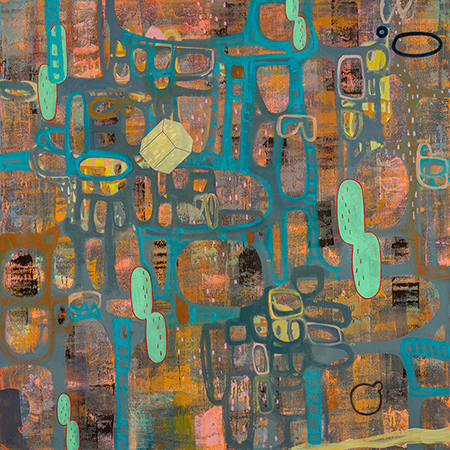
Continuing through August 26, 2023
Junko Yamamoto’s “Cosmic Web” follows her installation, “All is One,” at 4Culture, the gallery of the King County Arts Commission, in July. It typified a split within her work that has been growing for the past few years: stuffed, multiple-element floral and animal sculptures grouped on walls and, as Yamamoto shows at J. Rinehart, her better-known abstract paintings that combine elements of geometric shapes with curvy blobs of brighter color.
Twenty-five years ago, the Cornish College of the Arts graduate made her solo debut as an undergraduate. Since then, Yamamoto has consolidated her position in a variety of exhibitions in Seattle galleries as well as in group shows in Chicago, Ohio, Georgia, and Wyoming, and internationally in Japan, Italy, and Canada. Settling on a signature style consisting of a colorful under-grid layered with irregular shapes hovering over them, the Japanese-born artist’s stylistic growth has been so glacial and deliberate as to be barely noticeable from show to show. Here she makes a valiant attempt to complicate compositions by implicating mathematical and scientific systems, evident both in titles and overall appearance. For example, “Speed of Particles,” “Synchronistic Time,” and “Codes from the Sun” impose lateral and vertical lattices beneath and over randomly set single-color enclosures, as if they were biochemical or microscopic elements. The resulting interactions create the artist’s most complicated and interesting compositions to date.
Colors are never harmonious or decorative but, rather, conflicting, clashing, and exhilaratingly brash. Each painting locks in its components as if they were ignited energy systems run through an extraordinarily wide studio palette. Sometimes narrowed, each color set, as in “Invisible Current,” can also suggest emotional states of gloom or delight, approximating cubistic shallow space that alternately releases or suffocates the collective burst of color. Less successful in this respect, “Filament of Universe” contains a conglomeration of circles, squares and ovals, but mitigated by recourse to an oppressive black sludge seeping through. This is surprising in Yamamoto’s body of work. She normally has avoided the linear crutch of the color black when ordering her chromatic vocabulary.
More squares, ovals and circles appear throughout “Cosmic Web,” the show’s eponymous work, and are seen in a series of smaller wall elements, the “hand-sewn custom fabric taken from the artist’s prints.” Seen separately with fewer elements, they operate more as repetitive, modular ornament that threatens to tip her individual aesthetic into a purely decorative realm.
“Plasma” and “Lucid Flower” accentuate the sense of breathing, alternately inhaling or exhaling a sense of space controlled by choice of hot or cool colors, or as is often the case, both hot and cool in the same picture. Remarkably, there is little repetition of color combinations even though the formal elements that build up each composition —blobs, squares, ovals, circles — remain largely the same. The only advance in this grouping is a series of polyhedron shapes with inner linings that suggest a deeper intrusion into the picture plane but remain suspended over the lower grid. Yamamoto’s endless inventions also add a colorful outline to some of the irregular shapes, anchoring them in the composition as opposed to letting them float freely.
Occasionally, as in “Alternate Possibility” and “Collective Consciousness,” darker loops reach in from the sides of the paintings as if to grab or capture some of the calm activity going on. This is more apparent in a bigger wall installation, “Fibonacci Curve,” on a central free-standing wall in the gallery. Alluding to a mathematical system in which each number is the sum of the two preceding ones, this work builds upward in a spiral to an accumulated mass of colorful puffy toys, the stuffed fabric elements the artist has been incorporating for the past few years. The link is clear: the puffies are the source of the blobs. However, one wonders if this approach has been exhausted with this body of work which, despite its appeal, seems less dynamic than the recent bold wall installations of “All is One.” Yamamoto is not really a sculptor — nothing is truly three-dimensional or free-standing — but a painter who makes dimensional objects arranged on a wall. Yamamoto is now in need of fresh inspirations to break the dam of the current, slowly flowing river of her art.
